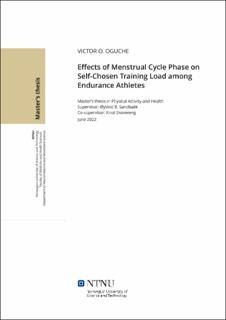| dc.description.abstract | ABSTRACT
Purpose
The menstrual cycle (MC) and its influence on performance and physical fitness in athletes has continued to gain interest in female sports. Even though recent studies indicate that overall performance is little or not affected by the MC phases, it is possible that endurance athletes alter their training load depending on the MC phases. Therefore, the main aim of this study was to ascertain if there are differences in self-chosen training load in the MC phases among endurance athletes.
Methodology
26 endurance athletes from 4 different regions in Norway, aged 17-43 years, eumenorrheic and non-hormonal contraceptives users were recruited. Athletes on hormonal contraceptives, anovulatory cycles or menstrual abnormalities were excluded from this study (3 exclusions from this study). All data were self-reported by the athletes and recorded using the Norwegian Olympic Federation training dairy, including: their daily total training time (in minutes) distributed across various training forms, activity form, training intensities and comments on how they experienced each session. MC was recorded on a menstruation form and tracked for a 3-month period. MC phases were determined using two methods; the calendar method and urinary luteinizing hormone test to detect ovulation. The early follicular (EF), late follicular (LF) and mid luteal (ML) phases were the phases determined in this study. Training impulse (TRIMP), total training volume (TV), the session rate of perceived exertion (sRPE) and amount of high intensity training (HIT) sessions were used to quantify training load and were compared across the MC phases to measure differences.
Results
No significant differences were found in self-chosen training load in the MC phases of endurance athletes (all p>0.05). Means and standard deviation (mean +/- SD) of the training load variables are given as TRIMP (EF=374.4 +/- 260, LF= 392.8 +/- 284.4, ML= 385.6 +/- 292.2), sRPE (EF=1.7 +/- 0.8, ML=1.7 +/- 0.8, LF=1.8 +/- 0.9), total training volume (EF=112.5 +/- 71.9, LF=119 +/- 72.5, ML=117.1 +/- 80) and HIT (EF=10.8 +/- 9.2, LF=10 +/- 8.9, ML= 8.7 +/- 8.1).
Conclusion
Findings of this study indicate that MC phases imposes a negligible effect on self-chosen training load among endurance athletes. Studies with a longer follow-up of athletes and larger sample size could be beneficial in future studies. | |
